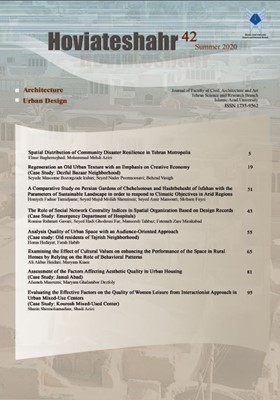توزیع فضایی تاب آوری در برابر سوانح در سطح محلات کلانشهر تهران
الموضوعات :الناز باقرنژاد 1 , محمدمهدی عزیزی 2
1 - پژوهشگر دکتری شهرسازی دانشگاه تهران، تهران، ایران.
2 - استاد دانشکده شهرسازی، پردیس هنرهای زیبا، دانشگاه تهران، تهران، ایران
الکلمات المفتاحية: تابآوری در برابر سوانح, توزیع فضایی, کلانشهر تهران, تحلیل عاملی,
ملخص المقالة :
خسارات بسیار جانی و مالی ناشی از سوانح طبیعی در کلانشهرها ضرورت ارزیابی و ارتقای تابآوری پیش از وقوع حادثه را نشان میدهد. کلانشهر تهران که مستعد زمینلرزه است، نیز از این امر مستثنا نیست. لذا در مقاله حاضر، مجموعهای از شاخصهای تابآوری از سه مدل ۱BRIC، ۲CRI و ۳CDRI، شناساییشده و جهت ارائه شاخص ترکیبی چندبعدی تابآوری کلانشهر تهران مورداستفاده قرارگرفته است. بامطالعه ۳۶۸ محله تهران و با استفاده از روش تحلیل عاملی اکتشافی، ابعاد تابآوری در پنج بعد اجتماعی، بعد زیرساختی، بعد عملکرد اقتصادی، بعد جامعهایروابط همسایگی و بعد جامعهای-مشارکت- تعریفشدهاند. توزیع فضایی تابآوری و ابعاد آن در سطح کلانشهر تهران نشان میدهد که محلات غربی و جنوبی شهر تهران و برخی از محلات در شمال شرقی وضعیت نامطلوبی ازنظر تابآوری دارند. درصورتیکه میزان تابآوری در محلات مرکزی و شرقی به نسبت بیشتر است. در میان ابعاد تابآوری نیز بعد زیرساختی بیشترین تأثیر منفی را بر محلات با وضعیت نامطلوب تابآوری داشته است.
امیری، محمدجواد؛ سپهرزاد، بهناز؛ معرب، یاسر؛ و صالحی، اسماعیل. (۱۳۹۶). ارزیابی تابآوری ساختاری-طبیعی کاربری اراضی شهرها، نمونه موردی: منطقه ۱ تهران. فصلنامه تحقیقات جغرافیایی، ۳۲ (۱)، ۱۳۷-۱۴۸.
رضایی، محمدرضا؛ مجتبی، رفیعیان؛ و حسینی، سیدمصطفی. (۱۳۹۴). سنجش و ارزیابی میزان تابآوری کالبدی اجتماع های شهری در برابر زلزله، مطالعه موردی: محله های شهر تهران. پژوهش های جغرافیای انسانی، ۴۷ (۴)، ۶۰۹-۶۲۳.
زبردست، اسفندیار. (۱۳۹۳). طرح مطالعاتی سنجش وضعیت پایداری شهری در کلانشهر تهران، معاونت شهرسازی و معماری شهرداری تهران.
صالحی، اسماعیل؛ آقابابایی، محمدتقی؛ سرمدی، هاجر؛ و فرزادبهتاش، محمدرضا. (۱۳۹۰). بررسی میزان تابآوری محیطی با استفاده از مدل شبکة علیت. محیط شناسی، ۵۸، ۹۹-۱۱۲.
Abdrabo, M. A., Mahmoud, A., & Hassaan. (2015). Urban Climate an Integrated Framework for Urban Resilience to Climate Change – Case Study: Sea Level Rise Impacts on the Nile Delta Coastal Urban Areas. Urban Climate, 14, 554–65.
Ainuddin, S., & Jayant, K. (2012). Community Resilience Framework for an Earthquake Prone Area in Baluchistan. International Journal of Disaster Risk Reduction, 2, 25–36.
Bergstrand, K., Brian, M., Babette, B., & Yi, Z. (2015). Assessing the Relationship between Social Vulnerability and Community Resilience to Hazards. Soc Indic Res, 122 (2), 391–409.
BRR. (2011). Resilience Capacity Index. Building Resilient Regions, January 1, 2013, from https://resilientneighbourhoods.ca/resilience-capacity-index/.
Burton, C.(2015). A Validation of Metrics for Community Resilience to Natural Hazards and Disasters Using the Recovery from Hurricane Katrina as a Case Study. Annals of the Association of American Geographers, 105 (1),67-86, from https://doi.org/10.1080/00045608.2014.960039..
Carpenter, S., Walker, B., Anderies, M., & Abel, N. (2001). “From Metaphor to Measurement: Resilience of What to What?” Ecosystems 4 (8), 765–810. https://doi.org/10.1007/s10021-001-0045-9..
Cutter, S. L. (2016). The Landscape of Disaster Resilience Indicators in the USA. Nat Hazards, 80, 741–758, from https://doi.org/10.1007/s11069-015-1993-2..
Cutter, S. L., Ash, K., & Emrich, C. (2014). The Geographies of Community Disaster Resilience. Global Environmental Change, 29, 65–77, from https://doi.org/10.1016/j.gloenvcha.
Cutter, S. L., Barnes, L., Berry, M., Burton, C., Evans, E., Tate, E., & Webb, J. (2008). A Place-Based Model for Understanding Community Resilience to Natural Disasters. Global Environmental Change, 18, 598–606.
Cutter, S. L., Burton, C., & Emrich, C. (2010). Disaster Resilience Indicators for Benchmarking Baseline Conditions. Journal of Homeland Security and Emergency Management, 7 (1), 1-22.
Davoudi, S, Shaw, K., Haider, L. J., Quinlan, A., Peterson, G., Wilkinson, C., Fünfgeld, H., McEvoy, D., Porter, L., & Davoud. (2012). Resilience: A Bridging Concept or a Dead End? ‘Reframing’ Resilience: Challenges for Planning Theory and Practice Interacting Traps: Resilience Assessment of a Pasture Management System in Northern Afghanistan Urban Resilience: What Does It Mean in Planni. Planning Theory & Practice, 13 (2), 299–333.
Frazier, T. G., Courtney, M. T., & Raymond, J. D. (2013). Spatial and Temporal Quantification of Resilience at the Community Scale. Applied Geography, 42, 95–107, from https://doi.org/10.1016/j.apgeog.
Habitat III. (2016). Draft Outcome Document of the United Nations Conference on Housing and Sustainable Urban Development. In United Nations Conference on Housing and Sustainable Urban Development, Oct 17 – 20, (1–22). Quito, Ecuador.
Mayunga, J. S. (2007). Understanding and Applying the Concept of Community Disaster Resilience: A Capital-Based Approach. A Draft Working Paper Prepared for the Summer Academy for Social Vulnerability and Resilience Building, 22 – 28, Munich, Germany.
Norris, F. H., Stevens, P. S., Pfefferbaum, B., Wyche, K., & Pfefferbaum, R. L. (2008). Community Resilience as a Metaphor, Theory, Set of Capacities, and Strategy for Disaster Readiness and Strategy for Disaster Readiness. Am J Community Psychol 41,127–150, from https://doi.org/10.1007÷÷/s10464-007-9156-6..
FM Global(2016). Annual Repot of THE FM GLOBAL RESILIENCE INDEX, Johnston, Rhode Island, United States from https://www.fmglobal.com.au.
Peacock, W. G., Brody, S. D., Seitz, W. A., Merrell, W. J., Vedlitz, A, Zahran, S., Harriss, R. C., & Stickney, R. R. (2010). Advancing the Resilience of Coastal Localities: Developing, Implementing and Sustaining the Use of Coastal Resilience Indicators: A Final Report. Hazard Reduction and Recovery Center, Texas A&M University, College Station.
Pendall, R., Foster, K. A., & Cowell, M. (2010). Resilience and Regions: Building Understanding of the Metaphor. Cambridge Journal of Regions, Economy and Society 3 (1), 71–84, from https://doi.org/https://doi.org/10.1093/cjres/rsp028.
Sherrieb, K., Louis, C. A., Pfefferbaum, R. L., Pfefferbaum J D, B., Diab, E., & Norris, F. H. (2012). International Journal of Disaster Risk Reduction Assessing Community Resilience on the US Coast Using School Principals as Key Informants. International Journal of Disaster Risk Reduction 2, 6–15, from https://doi.org/10.1016/j.ijdrr.2012.06.001..
Sherrieb, K., Norris, F. H., & Galea, S. (2010). Measuring Capacities for Community Resilience. Social Indicators Research, 99(2), 227-247.
UNEP. (2013). Building Urban Resilience, From https://doi.org/10.1596/978-0-8213-8865-5..
UNISDR. (2012). Making Cities Resilient—My City is Getting Ready, from http://www.unisdr.org/english/campaigns/campaign, accessed 8 February 2012.
Yoon, D. K., Kang, J. E., & Brody, S. M. (2016). A Measurement of Community Disaster Resilience in Korea. Journal of Environmental Planning and Management, 59 (3), 436–606, from https://doi.org/10.1080/09640568.2015.1016142.
_||_

